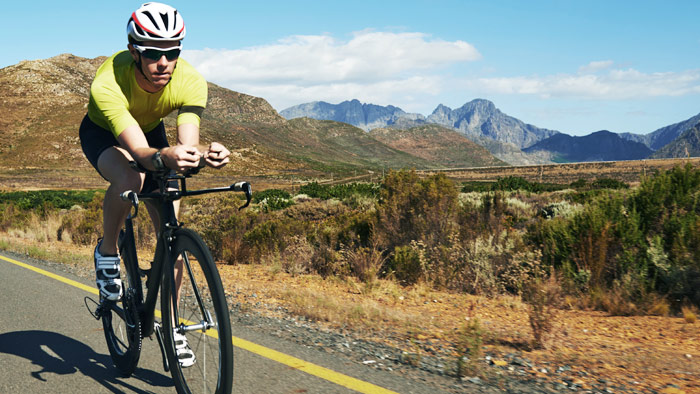We all know how much sports teams appreciate the edge home field gives. Broadcasters and fans alike will often refer to a stadium as being worth at least an extra man on the field. The familiarity of the surroundings, ease of getting to the game, and knowing the nuances of the playing field all contribute to this measure of comfort and confidence. When competing in a local 10k, being home allows the runner to use visual cues along the route to help make the race seem shorter or provide some local knowledge. Post-race, you will often hear stories of how athletes faltered because they didn’t know what to expect or weren’t prepared physically.
While your odds of performing at a higher level on your home course are greatly increased, it is a challenge when you have to travel to unfamiliar turf for your big race. For most athletes, training at a goal race venue for an extended period is not possible, due to distance or even the fact that the course isn’t accessible (such as highways or a city center used for a venue). Every race course is unique, and making yourself familiar with what the event holds is crucial for success. The goal is to study the demands of the course, train specifically, and give yourself as much of that “Home Field Advantage” as possible.
Roads and Weather Conditions
For the sake of this article I will focus on the bike only, but keep in mind specificity extends to every sport. Is your goal race course flat, undulating, or hilly? Are the roads fairly straight with gradual curves or are there lots of sharp corners requiring constant braking and accelerations? Will there be larger packs of athletes meaning variable pacing to avoid the draft? If so, this requires more interval training. If the field is thinned out on the bike, it allows for even rhythm riding, and your preparation should reflect this.
Also, consider the weather conditions. Is the course hot and humid? For heat acclimatization, one can add extra layers including tights and a hat, but it is more effective to do indoor riding with the heater and humidifier going at 80 to 95 degrees and 70 to 80 percent humidity. You can adapt considerably in three weeks. When and where do the winds kick up? Get out in the head and crosswind and practice eating and drinking. If you can’t find wind, athletes report success from the constant resistance of the trainer to prepare for headwind riding.
Course Specific Training
At its most basic, training for a hilly course means concentrating your key sessions in the final 8 to 10 weeks on terrain that isn’t flat. But that is a very general plan only. For instance, what makes the IRONMANCanada course in Whistler challenging is not only the 6000+ feet of climbing, or the sharp grades in the first 30 miles, but that the real climb comes at about 90 miles into the ride! The final 20 miles return to transition is all uphill!
Alternately, a course like Ironman Brazil is two relatively flat loops with the inclusion of four short but sharp climbs and descents each lap. Preparing for Whistler involves longer sustained climbs at the end of the ride, with some fast technical downhills and even a substantially flat portion in the aero bars. Brazil requires flat time trialing ability but also an anaerobic capacity to power up the climbs.
Course-specific bike prep can be done regardless of the terrain or environment where you live when you get creative. If you live in a hilly area and have chosen a flat race, for example, complete target wattage intervals on the trainer while remaining in the aero position. One of the challenges of flat courses is remaining in the aero position for hours at a time. Do some flat work on the trainer, and then give your brain a break and finish off the ride outside with 5 to 8 low cadence hill repeats of between 6 to 10 minutes in the aero bars to build strength.
Choosing a hilly race while living in flatlands requires similar planning. If you divide the workout into segments like the Ironman Canada simulation below, use over-gear with hands on the hoods to simulate climbing and high cadence in aero bars to simulate fast descents (include a tailwind if possible).
Since not all training is at race distance, athletes should examine their rides and select local routes that can break the course down allowing one to focus on specific features that will be encountered during the race. Time duration can be adjusted to keeping the proportions in line with the overall time of the workout.
Simulation Workouts
These rides use Functional Threshold Power® (FTP®) to guide your effort. You can also use the same percentages of your Lactate Threshold Heart Rate.
Hilly Course Simulation Workout
Below is an example of a 6: 00-hour ride in preparation for a hilly course, like Ironman Canada. This can be done outside choosing a route that allows steady effort and finishes on a long climb (or have a trainer set up and end the ride stationary).
- 40 minutes at 95 to 110rpm and 70-75 percent of FTP switch gears to vary cadence
- 30 minutes at 55 to 65rpm 80-85 percent of FTP
- 20 minutes at 100rpm 70 percent of FTP
- 40 minutes at 65 to 75rpm 80-85 percent of FTP
- 60 minutes at 95 to 110rpm 70-75 percent of FTP switch gears to vary cadence, include 2 x 2 minutes at 55rpm at 80 percent of FTP
- 90 minutes at 85 to 95 rpm in aero position 80 percent of FTP
- 90 minutes at 55 to 65 rpm 80-85 percent of FTP
Flat Course Simulation Workout
This workout is an example of a flatter course, like Ironman Brazil, simulation ride. This ride is 5 hours of flat riding with steep climbs of 3 to 4 minutes.
- Warm Up: Build 30 min gradually to 75 to 80 percent of FTP
- Main Set: Maintain 80 percent of FTP for flat TT portions between hills. Climbs @ 90 percent of FTP
- at 55 to 65 RPM.
- Hill timing is: 60 min (4 minute hill), 80 minute (3 minute hill), 100 minute (3 minute hill), 120 minute (4 minute hill), 180 minute (4 minute hill), 200 minute (3 minute hill), 220 minute (3 minute hill), 240 minute (4 minute hill).
- * 4-minute hills on a 5 to 7 percent grade, 3-minute hills on an 8 to 10 percent grade
Coaches can further help their athletes with software like BestBikeSplit. This program uses threshold power as a basis for outputs on the flats, hills and descents. By setting your goal finishing times or the power output that you have trained for, you can fine tune where and how strong the efforts should be on any given race course.
By turning unknown variables concerning terrain, road surface, and climate into knowns that are familiar and trained for, you will have the best chance of success, mimicking the “Home Field Advantage”!
“Thank you to LifeSport Senior Coach Dan Smith for his contribution to this article”



